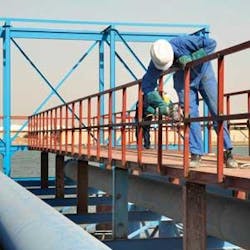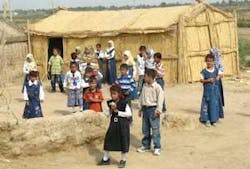Three communities show Iraq’s water progress
By A. Al Bahrani, Kendal Smith and Norris Jones
Three recent reports from the U.S. Army Corps of Engineers (USACE) demonstrate how efforts to rebuild water and wastewater infrastructure across Iraq are showing increasing signs of success at providing clean water and sanitation systems for the people of this war torn country.
Boost for Basra
Basra Province will soon see a dramatic increase in the availability of clean water. The $9.5 million water project will increase the Qurmat Ali water facility’s capacity from 4,000 to 16,000 cubic meters per hour (m3/h).
Mahmood Lafta, Basra water directorate’s design team chief, says the facility’s production will be sufficient to meet the needs of most neighborhoods throughout Basra Province including: Az Zubair, Khor Az Zubair and Umm Qasr.
He noted that once complete, Qurmat Ali will lessen Basra’s dependence on the Sweetwater Canal pump station 90 km north of the city. Taking its water from the Shatt al Arab River, the water facility is just 9 km north of Basra.
“Qurmat Ali will work as an alternative so if the Sweetwater Canal pump station is closed for maintenance or other reasons, the newly-expanded facility will be more than capable of providing fresh water to the people of Basra,” Lafta pointed out. Apart from the renovation work, the project includes a new chlorine building and chlorination system, a 3,000-m3 ground storage tank, a new steel intake structure, as well as two new 400-m3/h water treatment units. The Iraqi crew is currently installing a new switch gear room, two 5-megavolt amp transformers, and four new 1-megavolt backup generators.
“We’re very satisfied with the construction quality and our engineers are getting more experience by working side-by-side with the contractor’s staff which will ensure a successful transition once the project is finished,” said Lafta.
“This is an important improvement for Basra’s 2.5 million residents who will now have two independent sources of water for their household needs.”
Providing contract over-watch for this project, the USACE Gulf Region Division is helping to jump start Iraq’s economy and build a strong foundation for the country’s success by hiring locals to perform the work and purchasing project materials within the country. Since begun in January 2008, about 70 local Iraqis were employed on the construction crew and materials were bought from area businesses.
Sadr City celebrates
Clean water is a first for millions of residents of the Sadr City area of Baghdad with completion of a project begun in 2005 as a USAID contract.
“I am very happy for the 2 million people of Sadr City. I’ve been working here at the R-3 Water Treatment Plant for more than three years, since the start of the project. It’s the first in Iraq, fully automatic and with American standards of best quality. We meet the people in the streets of Sadr City and they are very happy. They feel we are interested in them and their health. We are very proud of the success of this project,” said Iraqi engineer Aqeel Lami.
Final construction of the $27 million Sadr City plant was handed over to the USACE Gulf Region Division in July 2007 to finish the remaining 15%.
“The plant location came as a result of a government study on water pressure and supply,” said USACE water expert Simeon Francis, who has been with the plant as a technical expert from its beginning with USAID. “There’s simply not enough water to Sadr City from the Kharkh and Shark-Dijilih Water Treatment Plants for the area.”
Experts decided to add a plant on the northern fringe of Sadr City to remedy that, he said. The plant began operation in mid-June with some interruptions due to power restrictions, but today, R-3 puts 4,000 m3/h of treated water into the distribution system through a 1.2 m outlet line. It’s currently providing 27 sectors in Sadr City with clean potable water — sectors that historically have had no centrally distributed water. With the plant at full capacity as of Sept. 27, 2008, a performance test in October confirmed the quality of the daily output of 96,000 m3/day (about 25 million gallons per day). That output equates to clean, quality water for a total of 1.5 million people in Sadr City and Baghdad, Francis said.
“Operating at full capacity, the R-3 Water Treatment Plant drastically increases the potable water to the people of Sadr City. The plant is operating at 100% capacity right now. It’s a great success story for USACE,” said project engineer Roland Belew.
The plant will employ 150 people for operations, maintenance and management, Belew explained.
“This project is special to me,” concluded Francis, “because I’ve been here from the beginning, and I am here for the end of it. It’s really something to see the clear water sample from R-3’s output. I know what the raw water is like from the Tigris and to be able to look at the R-3 water and see nothing but water is very gratifying,” he concluded.
Quenching Al Shofa
Families in a small village north of Nasiriyah in Thi Qar Province anxiously await completion of a water treatment facility that will provide them a local source of clean drinking water for the first time ever.
About 1,500 residents live in the Al Shofa neighborhood, which will be served by the new 50-m3/h facility. Dozens of Iraqis have been involved on the construction crew for the nearly $350,000 project that includes 4 km of a water distribution network. Among those getting access to the treated water is the local Al Qitab primary school and the 120 students attending classes there.
“Our community was pumping raw water out of a canal for household use. It was not good water,” explained headmaster Farage Jabbar Ali. “We are all very happy to see this project nearing completion.” USACE has completed more than 830 other water projects in Iraq and nearly 80 more are ongoing.
The work is being overseen by Navy Commander Terry Hart with the U.S. Army Corps of Engineers. “Everyone we talk to there has been very supportive,” he noted. The project began a year ago and should be finished next month. It includes an intake structure, 50-cubic-meter elevated storage tank, operations building, chemical and storage building, back-up electrical generator, and a perimeter wall. Cdr. Hart’s staff is overseeing the construction of 15 water treatment plants in Thi Qar Province.
“This is what it’s all about — helping people. I’m pleased to be part of this effort providing Iraqi families access to a fundamental necessity. They’re delighted to see it taking shape and grateful for what we’re doing,” said Hart, a Naval Reservist from Frankenmuth, Michigan.
“We’re making a difference. This project lets them know their government is working and things are getting better,” she said.
Authors’ Notes:
A. Al Bahrani, Kendal Smith and Norris Jones are public affairs officers for the Gulf Region South district, U.S. Army Corps of Engineers, Iraq. Al Bahrani shot the photos for the Sadr City project and Jones for the Al Shofa project. For more information, contact public affairs at +1-540 665-1233, [email protected] or www.grd.usace.army.mil





